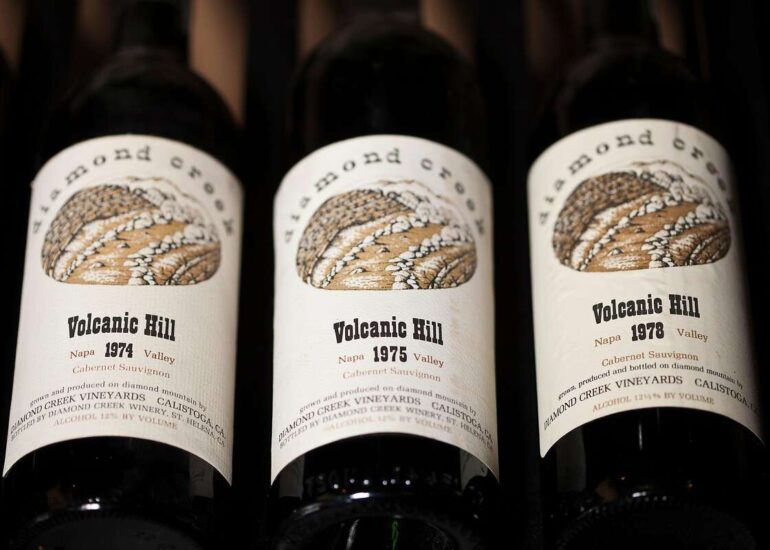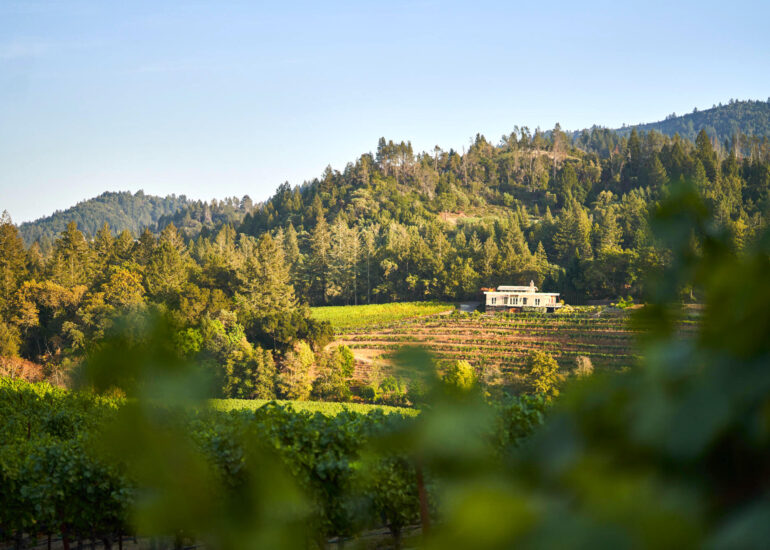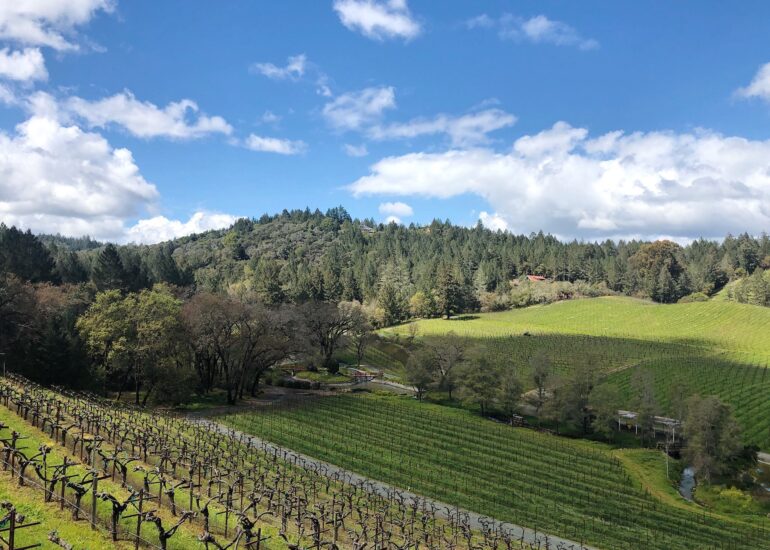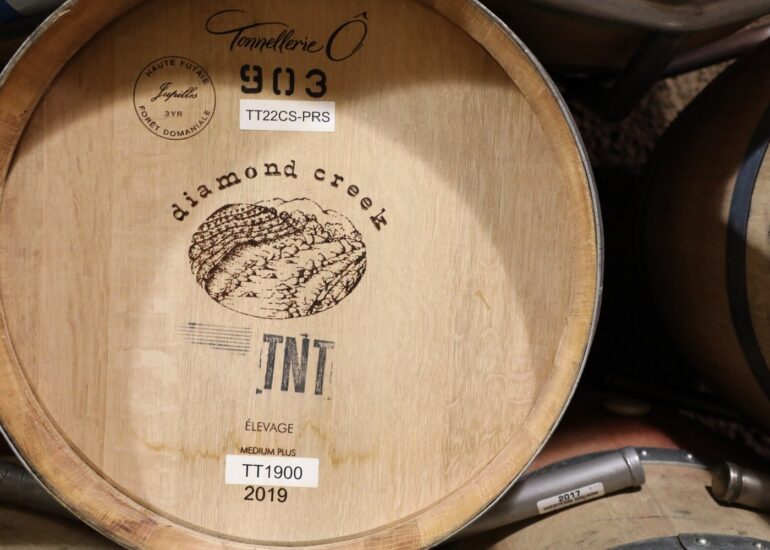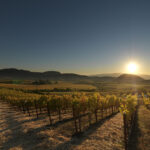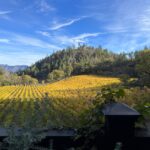A Diamond is Forever
Winemaker Interview
A Diamond is Forever
A conversation with (the late) Boots Brounstein and Philip Ross of Diamond Creek Vineyards in Napa Valley
The Legacy of a California Icon Continues to Champion Terroir in Napa Valley
An Interview with the Heirs of Diamond Creek Vineyards
In the epic tale behind California’s wine industry, Diamond Creek Vineyards is a legend in itself. Yet little did its founder, the late Al Brounstein, know at the time he bought his land in 1968 that he would later be making lasting history with the methods he chose to craft his quality driven Cabernet Sauvignon. With a combination of keen instinct, enterprising creativity, and fearless determination, this entrepreneur not only invested in an area previously unknown for grapegrowing in the Napa Valley, but cultivated it with vine cuttings from the finest Bordeaux châteaux. Designating separate bottlings of his wine according to the three distinct soil types he later discovered in the process of developing his vineyards, Brounstein was among the first in the United States to take the French concept of terroir, or the influence of place on a wine’s character, and quite literally plant it here in California. Unabashed, unorthodox, and uncompromising, this man was one of a handful of pioneers to have set Napa on a course that has since shaped its identity as a world-class winegrowing region, ultimately influencing the production of fine wines in other regions of the country. Curious to learn first hand about the inception, development, and present state of this legendary producer, I spoke with the current proprietors of Diamond Creek Vineyards: Al Brounstein’s widow, (the late) Boots Brounstein, and her son Philip Ross.
Visiting Diamond Creek, one is met with two striking features. The first and perhaps most surprising of these is the proximity to one another of its three vineyards — Red Rock Terrace, Volcanic Hill, and Gravelly Meadow. Separated only by a few meters, the marked differences in their soils becomes all the more apparent, and further underscores the uniqueness of this site. While I briefly wondered about the geological events that produced this profound effect eons ago, I was mesmerized by the property’s other extraordinary feature: its meticulously landscaped gardens that serve as colorful accents around the small vineyards. With its central lagoon, numerous footbridges, and even a few waterfalls, it’s easy to forget that this bucolic scene is a site where premium Cabernet Sauvignon is cultivated. It nonetheless speaks volumes about the late Al Brounstein and his reverence for the natural environment and its wonders — a quality that, to this day, is core to the management of Diamond Creek Vineyards.
— Nikitas Magel
Following are edited excerpts from the interview. At the bottom of this post is the full recording.
What’s Old is New Again
Nikitas Magel: Al Brounstein was ultimately known for going against the grain in producing his Napa Valley wines in the late ’60s, by using as inspiration the finest wines of Bordeaux and Burgundy. Tell me what influenced him to look to the Old World while many of his colleagues at the time were trying to create something from scratch here in California.
Philip Ross: Today there are a lot of Cabernet clones from all over the world that are planted here. In those days, though, whatever happened to be available was what was planted. People weren’t thinking about selecting out the best clones or making the best wine. It was the era when researchers were still talking about and experimenting with hybrids, and essentially re-inventing the wheel — rather than saying, as Al did, “Gee, why don’t we go to the best wine regions of the world and see what we can learn about doing the same things here.” Not many people in the Napa Valley at that time were thinking strategically along those lines. Al was among the first, along with a handful of other vintners — Joe Heitz, Warren Winarski, and Robert Mondavi, just to name a few. Much of what had been going on in the valley had nothing to do with making world-class varietal wines that could compete with those from the Old World. This was a mindset that was only just beginning.

PR: After Al got advice from André Tchelistcheff, Louis Martini, and a few other folks, he decided to purchase this property. In doing so, he felt that he’d found what could be the best site for Cabernet in the Napa Valley. And what he wanted to do was create a world-class wine to compete with Bordeaux. But there wasn’t a lot of Cabernet Sauvignon planted in the state [of California] at the time and he wasn’t happy with the clones that were available. So, in his mind, the best thing to do was to go talk with the French, because that’s who he wanted to emulate. And that’s exactly what he did: he went to Bordeaux and, with his fluent French, talked to the workers in the fields of the top Chateaux. And they were actually very willing to talk about what they were doing because they were so proud of it. Once he felt he had gained enough knowledge from the vineyard workers, he went to the owners of three of the five First Growths and negotiated with them to get some of their vine cuttings. But since he couldn’t ship them directly to the States because of the [agricultural] quarantine, he had the cuttings sent to Mexico City and from there up to Rosarita Beach where he had his own airplane. He then flew the cuttings himself up to vineyards here. And this was all so innovative, to say the least — not to mention dicey— which shows you the type of man he was!
Boots Brounstein: Not very many people would have taken the chance of smuggling cuttings into the country! {laughing}
A Diamond in the Rough
NM: It was quite a risk, but clearly one that paid off! Another risk that Al took, by virtue of its complete lack of precedence, was his choice to plant grapevines on Diamond Mountain. Tell me about that decision and what it was that gave him to confidence to move forward with it.
PR: First of all, Al knew he wanted mountain vineyards. His first real experience of making wine involved hillside fruit because, after completing courses at UCLA on French wines, he went to work the harvests at Ridge Vineyards — and Ridge back then, as it is today, was making very good wines. Now, with mountain fruit, as you know, you tend to have small berries with intense flavors and inherently low yields. Secondly, Al was never shy about asking advice from anybody, though as an entrepreneur and risk-taker in his own rite, he would always make the final decision. And he brought some very prominent people up here [to give him advice on the site] — André Tchelistcheff, Louis Martini, and Dick Steltzner, who was very well known in the valley as a fine vineyard manager, even back then. These folks, amongst others, said that if it were them using their own money, they wouldn’t feel badly about taking a chance on this property as a site for growing fine winegrapes. They acknowledged that it was still a risk, but that there was no reason to think you couldn’t make a world class wine here. At the same time, other people — who weren’t themselves risk-taking entrepreneurial types — told him they were not comfortable with the risk because nobody before had planted European varietals on Diamond Mountain. Those people said, “We don’t know how these plantings will do here; you’d better go over to Spring Mountain because there’s been some history there already.” So, he had to weigh these considerations.

PR: But the overriding factor helping him to decide on it was the beauty of this place. He fell in love with it. One thing that Al had was the ability to visualize. We all lived in Los Angeles, and before he bought this property, he would often fly his airplane up here and all over the valley, just to look for property. And though this wasn’t the only place he looked at, he knew what he had here: an amazing spot, one of the prettiest in the valley. If he really felt strongly about something, he just did it. Plus, keep in mind, André Tchelistcheff and Louis Martini were no lightweights in the wine industry — they, along with a few other very knowledgeable people told Al they thought he could make this work. So, taking those things together, he finally pulled the trigger and bought the property.
Now, what’s interesting is that originally he was wanting to make just one wonderful, world-class Cabernet; in his mind, he had no plans to make three or four different Cabernets. The idea for that came in the process of developing the vineyards. On one day, he would be working on the tractor in one vineyard and find himself covered in red iron soil; on another day he’d be clearing the second vineyard and end up covered in a white volcanic ash; on yet another day, in the third vineyard, he would find all these large rocks in the soil.
So — talk about taking risks — he decided to keep the wines he produced from these three different vineyards in separate barrels for two years, naming them respectively, Red Rock Terrace, Volcanic Hill, and Gravelly Meadow. He wanted to see if there would end up being differences in the resulting wines, since they came from such different soils. But this is something nobody was doing! No one here was using the word terroir! Wouldn’t you agree, Boots, that Al was the first to talk about terroir?
BB: Oh, yeah! Nobody understood the word! I mean, of course, here in the United States.
Bordeaux Aspiration, Burgundy Approach
NM: Now, to what extent was Al’s choice — to manifest and express the unique terroir of these individual vineyards — based on his speculation from what he discovered on his own about the very different soil types, versus on the learning he gained through his conversations with the vineyard workers of top Bordeaux chateaux?
PR: It was a combination of both. Without his knowledge of the importance that the French place on terroir, he would not have done any of this. And what the French were doing was of the utmost importance to Al, because in the early-to-mid ’60s, when it came to the best wines of the world, most people were talking about what the French were doing. So this became his philosophy of how he would develop his own grapegrowing and winemaking here in America. It can’t be overemphasized: he did not want to invent something new; rather, he wanted to emulate what the French were doing. He would say, “I think that the French have it right. I think the French are making wonderful wines. If you look at the top wines of Burgundy and Bordeaux, they can’t be surpassed! And we could do that here in America.” He would look very closely at what the French were doing out in the vineyards, and then emulate that. That shows you how confident he was; he felt that if the French could do it, so could we, especially with the wonderful soils and weather we have in Napa.

NM: So, the industry, as we know it today, was spearheaded by a small and adventurous cadre of people who believed in something that had no basis in experience here in California, but which they nevertheless felt in their hearts that they could accomplish. And in doing so, eventually got UC Davis to look more closely into researching and ultimately validating what these winemakers were experimenting with on their own.
PR: I think that’s a fair statement. But what we’re also saying is that what was happening at that time was the birth of the fine wine industry here in California. And it’s come so far in the last 40 years.
BB: Interestingly, Al always felt he was making a Bordeaux wine in a Burgundy style. Because when he found out that we had different soils and terroir, [Domaine de la] Romanée-Conti became very important to Al. He and I went over there to visit, and saw how tiny Romanée-Conti really is. It’s very, very small! And he felt it was quite similar to what we had here: he wanted to produce the finest Cabernet Sauvignon that he could from his small property, just as Romanée-Conti was producing the finest Burgundy from theirs. That was always a big part of what influenced him, especially when he found the different soils and how closely together they were located.
PR: It gave him confidence.
BB: And it’s the same thing with many of these vineyards in Burgundy — Richebourg and Romanée-Conti — they’re all so close to each other and tiny. And that’s why he never wanted to expand or have more vineyards. He wanted to to remain at the small size that he was.
Pursuing a Sense of Place
NM: The fact that three vastly different types of soil converge here on one single site is really quite striking!
BB: But we didn’t know this when we bought the property. Which makes it even more intriguing.
PR: And it wasn’t just the soil diversity that worked unexpectedly in our favor. It was also the location and climate. In the summer we don’t get a lot of fog up here, at 800- 1000 feet, so we’re ripening the grapes in the morning. But then in the afternoon, we get cool breezes from off the Russian River corridor, which, when they meet the heat coming from down in the valley, create a circulation of air above all our vineyards. So we don’t have a frost problem. Plus, the vines are already starting to cool down in the afternoon, while the valley floor is still warming up. And that cooling effect, of course, retains the grapes’ acidity. But these are all things we discovered over the years about this site.
NM: Given that this location has so many qualities playing to its favor in growing fruit of exceptional quality, it was actually quite fortuitous that Al chose it, knowing actually very little about its real potential. It was almost as if he was destined to have chosen what ultimately turned out to be such a superb site!

PR: Yes, that’s right, that’s correct. It’s quite amazing. Now, as far as the different soils themselves, because Al already knew about the importance of soils in Burgundy and that there were world-class wines being made with the same varietal from very small vineyards only a few feet from each other, it gave him the confidence to feel that he could do the same thing here, although using a Bordeaux varietal. I do think he saw [his discovery of the very different soils] as an fortuitous opportunity. And I seriously doubt that at that point in history, anybody other than Al who might have purchased this property with the intention of planting vineyards would have seen the value of having different soil types. He recognized the importance of that, and felt confident he could manifest differences in the wines based on those soils, again because he knew it was already working in Burgundy. So, from the beginning, he kept the wines in separate barrels for two years to see if there would be any significant differences in them. In the cellar, he marked them accordingly, although he hadn’t yet established names for the vineyards. Once he found that there were, in fact, differences among them, he felt he could really start educating Americans on the importance of terroir by bottling and selling these wines separately — because if it had been in France, there’s no doubt that the wines would have been bottled and sold separately.
NM: This was revolutionary — history in the making, really.
PR: It was, at the time. But he got a lot of flak for what he was doing — no one understood it! He would go to a retailer and he’d say, “Hi, I’m Al Brounstein of Diamond Creek Vineyards.” (nobody heard of him, of course ) “And I have these three wines, three Cabernets from very small vineyards.” But retailers would kick him out their stores! They were convinced he was trying to trick them into getting three spots on their retail shelves!
BB: And he would never let them taste — “If you want to taste, you have to buy” — because he didn’t have very much of the wine. To this day, we’ve kept letters from top retailers who are still in business, telling Al exactly what Philip just said: “You have your nerve to expect us to give you three spaces [on our shelves]! You owe it to consumers to just blend the wines together from twenty acres!” And Al never called on those people again. This was the ’70s.
PR: If you look at our labels, they prominently show the names of the vineyards, which he named after the soils: Volcanic Hill has soil that looks like volcanic ash; Red Rock Terrace has red rocky soil; Gravelly Meadow has big chunks of rock. These names are printed in big letters! And that was revolutionary because it was done at a time when Americans thought of Burgundy simply as a red wine, rather than a place that represented a very specific style of wine. He believed so much in the concept of place, that even though he was proud to be making one of the best Cabernets in Napa, he didn’t want the words ‘Cabernet Sauvignon’ or ‘Napa Valley’ to be prominent on the labels —in fact, they’re very understated on the bottles to this day — because for him, it was all about a sense of place, a very specific place.
BB: He wanted the wines to be known [simply] as Volcanic Hill, Red Rock Terrace, and Gravelly Meadow — not as Cabernets from Napa. So if you would mentioned one of those vineyard names to someone, they would know it was Diamond Creek. On the other hand, even though Al really looked up to the French and was so involved in recreating something they had started, he felt that since we’re here in California, the wines should have a label in a style that was Californian, not French. Furthermore, he always thought of California as being very western and he wanted to promote that: “We, here in the west, can make fine wine.” And that’s why our label looks the way it does, ‘Old West’ and not in the slightest bit French.

NM: He struck a balance, then, in that he recognized there was tremendous value and significance in emulating the French in their extreme focus on a sense of place, but on the flip side acknowledged that California is nevertheless a very different region from that which he took his inspiration and therefore felt compelled to reflect that.
BB: Exactly — reflect and promote it! Promote it! That was very important.
NM: So, he was clear in his vision and intentions. But how did he go about actually carrying them out in the vineyards? Being new to all of this, how did he learn his viticultural practices?
PR: There was a lot of experimentation going on, and it was a fun time in the industry because of that. Everybody talked to each other. Everybody who was making Cabernet in Napa County — there weren’t that many — were talking to one another, seeing what each other was doing, sharing space and equipment. A lot of the early knowledge just came by doing, by trial and error, seeing what worked and what didn’t.
BB: One big help for Al came from our first consulting winemaker, Jerry Luper. Because although he did take a lot of classes and learn a lot about winemaking, Al would tell you from the very beginning that he was not a winemaker. But Jerry supported Al on his decision to bottle our vineyards separately, because he agreed with Al that they really were different. And that was huge because everybody else at the time was blending everything together. We were very fortunate that Jerry was part of our beginning.
PR: He was a wonderful winemaker. He went on to make wine in Portugal and recently retired.
BB: Jerry was a great influence. And he was very supportive. Although, Al didn’t really care about what anybody thought; he believed in himself. And that’s what carried Al: he believed in what he was doing and nobody was going to change his mind. He had a vision and had to do it his way!
From Limitation to Motivation
NM: He sounds like a very strong-willed man. Given that, I’m wondering how he managed all of this in the face of such a potentially debilitating disease as Parkinson’s.
PR: Al passed away after having had Parkinson’s disease for 25 years. But the thing is, it didn’t slow him down! Think about that: he had it for 25 years, so during the majority of his experience in building Diamond Creek he had this disease. I saw him depressed about it for maybe two days after the diagnosis — and that was it; then he got on with his life. Al actually became an inspiration to a lot of other people in the valley who had Parkinson’s; they would call him a lot because he would cheer them up! To him, he didn’t have a disability; he just happened to shake. He did a lot of public speaking, so with his wonderful sense of humor, he would create all these jokes to make people feel at ease with his disease. He’d been a private pilot but he eventually had to give up flying, he would tell people, because he was doing rough landings! {laughter} He also loved music, classical music. So, another joke that he told people was that he’d always wanted to be a conductor, but ever since he got Parkinson’s, he could only do fast numbers! {laughter} You can see his wonderful sense of humor. And he would do public speaking and fund-raising for Parkinson’s. Well over a million dollars have been raised for research on the disease from the efforts of Al, and my mother continues those efforts. In fact, at an annual event just last year, even in these economic times… what was raised, about $150,000?

BB: Oh, it was over $200,000. Robin Williams was one of our guests one year…
PR: And Michael J. Fox has been involved with it in the past.
BB: I earmark the money to go to the Parkinson’s Institute in Sunnyvale, California.
NM: So, you’re continuing his legacy in more than one way. That’s fantastic!
BB: Yeah… it is! And I’m determined. Because he was in good health, but finally the disease just takes the body. It’s a sad thing. So, I’m going to keep this going until there’s no more Parkinson’s! They’re getting close, but it takes a lot of money.
PR: So we’re continuing to do all the good work that Al created. My mother’s been involved since the beginning, and I’ve been involved for many, many years. We believe in what we’re doing here. And we’re small. We have no desire to grow or expand. We have our loyal customers and sell our wine throughout the world, including Russia and China.
Inspiration for the Future
NM: In retrospect, you’ve witnessed a tremendous amount of evolution in California’s wine industry, in part as the result of efforts by pioneers like Al. In light of that, what is your opinion of how the industry has developed in the recent past and where do you think it’s headed in the future?
BB: It’s difficult to speculate on where it’s headed. But what I think is very healthy is the enthusiasm that the younger generation is bringing to the industry. I think that’s wonderful! I also think that France is not nearly as much of an influence on this generation as it was for us, whereas I think California as a whole has become far more influential. And I think that’s outstanding! That’s what we want. We never want to forget the French and how their influence shaped things early on for us, but there are other countries today that are also making wonderful wines — Italy, Spain, Australia, even South Africa.
PR: There’s also been an evolution in the culinary arts that kind of parallels the evolution of wine over the last thirty or forty years. You have tremendous interest nowadays among Americans in the culinary, and that’s further fueled the fine wine industry. But it’s not all the same; all these chefs are doing their own thing, quite differently from each other, and they all have their followings. It’s the same thing with wine. There’s enough room for all styles. The important thing is to have many different styles of everything. The consumer will decide. Keep in mind that in the beginning of the wine industry in this country, it was an educational process; Americans were not confident in drinking wines because they simply didn’t know them.

PR: Now things have changed. Young people today are quite knowledgeable and comfortable around wines. It used to be that you’d go to a restaurant and see some wonderful bottles on the wine list, but the wines by-the-glass would always be inexpensive and low quality. But there’s been a tremendous evolution — and I was a huge advocate of this — where restauranteurs have finally started to take the risk of offering finer wines by-the-glass. This has been an educational process. And people who are really into wines get a great deal of their education by drinking wines by-the-glass in restaurants. There’s a tremendous interest now among consumers in wines from all over the world. And even just with Cabernet here in America with the different styles, consumers now have enough confidence that they can choose the style they want. That’s healthy. [In the meantime,] we believe in what we’re doing and we’ll continue to make wine the way we have been, because it’s the style that we like to drink ourselves.
And it’s with this same fidelity towards one’s own taste that Al Brounstein, himself, initially embarked on his endeavor to make terroir-driven Cabernet Sauvignon under the Diamond Creek label. This, along with his commitment to manifesting the unique qualities of the estate’s distinct vineyards, is a vision that Boots Brounstein honored until her death in 2019, and that her son Phil Ross continues to this day, nearly 60 years later. To learn more about these wines, visit Diamond Creek Vineyards online.
Interview by Nikitas Magel (originally recorded in 2010, updated in 2024)
Photos by Diamond Creek Vineyards

Comments are closed.

